To create a smooth paint surface, you must remove paint contamination.
Paint contamination consists of tiny metal shavings from rail dust, brake dust and industrial fallout. This contamination affects all paint finishes and can cause serious damage when left untreated. Paint contamination can be felt as a "rough or gritty" texture on the paint's surface and can lead to tiny rust spots. This contamination can not be removed by washing, waxing and/or polishing.

The picture to the left is actual paint contamination on a white vehicle.

Stage 1. Paint contaminants land on the paint's surface.

Stage 2. Paint contaminants start to oxidize.

Stage 3. Rust forms in the paint.
There are three major causes of paint contamination:
1. Rail dust - produced from the friction of train wheels against railroad tracks. Over 70% of new vehicles are shipped by rail. Rail dust can contaminate a new car's finish before it even reaches the dealership. Anytime a vehicle is parked or travels near a railroad it is subject to rail dust contamination.
2. Brake dust - particles produced from the friction of brake pads rubbing against the rotor. This metal on metal friction disperses tiny particles of bare metal into the air and on the highway where it collects on passing vehicles.
3. Industrial fallout - another word for pollution, industrial fallout is a byproduct of our modern industrial age.
"How can I test for paint contamination?"
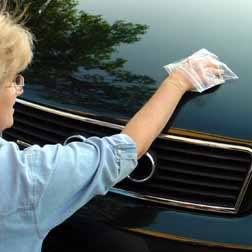 After washing and drying your vehicle, put your hand inside a plastic sandwich bag and lightly run your fingertips over the paint's surface. It should be as smooth as glass. If your car's surface has a rough, gritty or pebble-like texture, it indicates the presence of paint contamination. This should be removed with a clay bar before applying a polish or wax. After washing and drying your vehicle, put your hand inside a plastic sandwich bag and lightly run your fingertips over the paint's surface. It should be as smooth as glass. If your car's surface has a rough, gritty or pebble-like texture, it indicates the presence of paint contamination. This should be removed with a clay bar before applying a polish or wax.
There is no wax, natural or synthetic, or any chemical treatment that can prevent or protect against this contamination. Compounding with an abrasive polish may remove paint contamination but it can only be performed a few times before removing too much of the top, clear coat finish.
The best solution, a special clay bar, was developed in Japan nearly five years ago. This clay safely removes rail dust and industrial fallout by "pulling" it off the surface. It does not "cut" or perform any abrasive action normally associated with polishing or compounding.
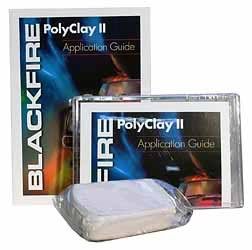 The latest evolution in clay technology is BLACKFIRE PolyClay. These clay-like bars are made in the U.S.A. of entirely man made polymers. These bars perform all the functions of traditional clay bars but have a number of advantages: The latest evolution in clay technology is BLACKFIRE PolyClay. These clay-like bars are made in the U.S.A. of entirely man made polymers. These bars perform all the functions of traditional clay bars but have a number of advantages:
1. Poly Clay does not dry out with age.
2. Poly Clay does not decompose with repeated applications.
3. A single non-abrasive grade works on all paint conditions yet is still clear coat safe.
4. Poly Clay is easier to work with. It pulls, stretches and refolds easier that normal clay.
5. Poly Clay leaves almost no residue on the surface making clean-up much easier.
Clay bars should always be used on freshly washed, clean surfaces. Dirt on the surface could cause scratches.
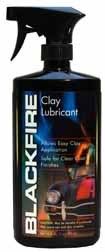
Always use a lubricant such as BLACKFIRE Clay Lubricant with the clay bar.
Work on areas about three square feet. Lightly mist the surface with the lubricant. Place the clay bar in the palm of your hand and rub it across the lubricated area using moderate pressure. (Hard rubbing is not required)
You should feel a slight grabbing at first. As you rub, the bar should glide smoothly over the surface. When the bar moves freely you are done. Wipe the surface with a clean dry towel and continue in sections until the entire vehicle is complete.
|

Mist the surface with lubricant, rub clay across surface.
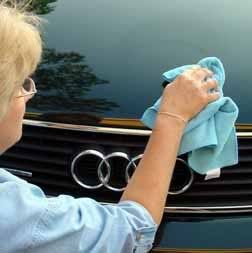
Wipe off any residues with a soft towel.
As the bar becomes soiled, simply pull, stretch and refold to expose a new, clean side. When the bar becomes totally soiled (dark colored) discard it. I like to cut the 8 oz bar in half. A 4 oz. bar should clean at least 7 to 10cars. Do not use a bar dropped on the ground.
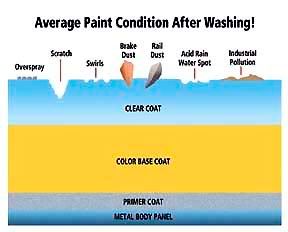
Before claying.
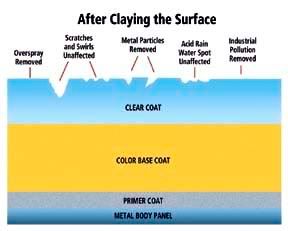
After claying the surface. No contaminants.
After claying, the surface should be as smooth as glass. Remove any remaining smudges with a clean dry towel. Microfiber towels like our Multi-Task Detailing Cloths are perfect for removing clay residues. Mist the surface with the lubricant if necessary to make the final wipe down easy. Tech Note: Clay bars will not remove scratches, swirls, dull, oxidized paint or restore surface gloss. This is accomplished by polishing the surface after claying. Polishing alone will not remove paint contamination. After claying the surface, you have two options. If the vehicle's paint is in like-new condition (good paint gloss and no swirls), you can finish by applying your favorite wax or paint sealant. If the finish shows any swirls or lacks luster, polish with a swirl remover or finishing polish and then apply a final coat of wax or paint sealant. Poly Clay will not remove paint or the clear coat finish. It can be used as often as necessary to keep the surface free of contamination and smooth.
Always apply a protective coat of wax or paint sealant after claying the surface.
|
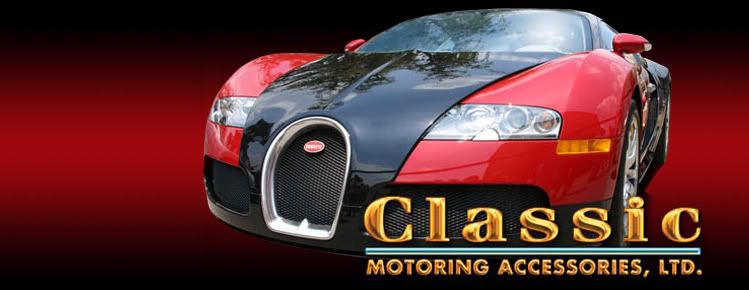

Great info there. The amount of times I've heard people say "it needs a respray" because the paintwork is covered in bonded contaminants and feels rough is unreal! Clay is such a vital part of the detailing process and if you want that glassy smooth finish you must clay!